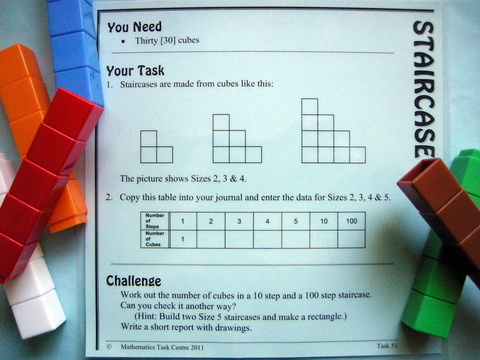
StaircaseTask 51 ... Years 4 - 10SummaryStudents build towers of cubes, each one being one block higher than the previous and in this way create a staircase. The challenge is to predict the number of blocks needed to build a staircase of a given height.Staircase also appears on the Picture Puzzles Pattern & Algebra A menu where the problem is presented using one screen, two learners, concrete materials and a challenge. The extra challenges in this puzzle make a link to Task 18, Same or Different, and a template for creating new Triangle Numbers from smaller ones. Also Staircase is the stimulus investigation for the DIY workshop video Aiming High? Dig Deeper which explores a pedagogy of achieving high aims in mathematics by digging deeper into fertile learning ground such as this task, rather than too quickly moving on to something new. The video highlights teaching craft - for example visual and kinaesthetic learning and journal writing in maths - and uncovers mathematics content from Year 1 to Year 12. Its introductory video Staircase Maths (in less than one minute) will give you an idea of the content (and teaching craft). |
Materials
Content
|

IcebergA task is the tip of a learning iceberg. There is always more to a task than is recorded on the card. |
This task can be extended using Task 61, Double Staircase. The action of building the staircase is well within the grasp of quite young students. It is also possible for them to work out the total of blocks for a 10-step stair, and perhaps even a 100-step stair. The first they might do by building the staircase and counting, or by adding up the numbers from 1 to 10. For the second they might use a calculator. If the focus of the problem was the answer, then this could be all we required. However, if the focus is learning to work like a mathematician, then we need to ask the mathematician's question: Can I check it another way? This may encourage students to look for connections within the set of numbers, rather than looking at each number as a separate object. Then, in adding 1 to 10 for instance, they might look for 10s and pair 1 with 9, 2 with 8, 3 with 7, 4 with 6 and realise that the total is therefore 5 tens plus the unpaired 5, which is 55. However, visually-based approaches can also work and are to be encouraged:
|
Whole Class InvestigationTasks are an invitation for two students to work like a mathematician. Tasks can also be modified to become whole class investigations which model how a mathematician works. |
For more ideas and discussion about this investigation, open a new browser tab (or page) and visit Maths300 Lesson 115, Staircases, which includes an Investigation Guide. Visit Staircase on Poly Plug & Tasks. |
Is it in Maths With Attitude?Maths With Attitude is a set of hands-on learning kits available from Years 3-10 which structure the use of tasks and whole class investigations into a week by week planner. |
The Staircase task is an integral part of:
The Staircases lesson is an integral part of:
|